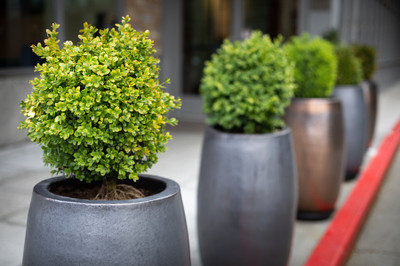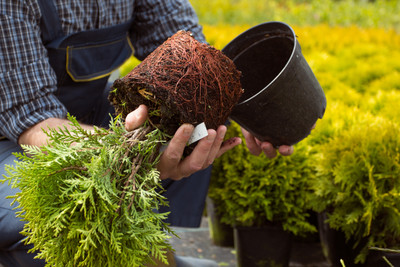Why Fiberglass Planters Are the Best Choice for Commercial Landscaping?
Posted by Jason Wyrwicz on May 8th 2025

In many commercial settings, the exterior and interior landscapes serve as an immediate introduction to a company’s identity.
When potential customers walk up to a storefront or enter a lobby, what they see can influence how they perceive the organization’s professionalism and commitment to quality.
Planters play a vital role in this setting. They add life and color to patios, walkways, rooftops, and indoor lounges, complementing a property’s architecture or design theme.
If you are searching for commercial landscaping ideas—perhaps for a new dining patio, a corporate campus, or a retail complex—this guide will help you understand why fiberglass planters specifically are worth considering.
Common Challenges in Commercial Landscaping
Commercial properties often encounter obstacles that go beyond adding decorative shrubs or setting out a few chairs. Below are a few common hurdles that highlight the importance of well-chosen planter materials:
- Exposure to Harsh Weather: Many regions experience freezing winters, hot summers, wind, and heavy rain. Pots and planters that cannot stand up to these extremes may crack, fade, or warp.
- High Maintenance Costs: Watering demands, cleaning schedules, and frequent replacements can become expensive, especially if a property is large or spans multiple sites.
- Need for Durability: In busy retail centers or hotel lobbies, planters need to remain intact despite being bumped, moved, or exposed to wear and tear.
- Design Consistency: For a chain of restaurants or stores, creating a cohesive brand image across locations is essential. Different materials can look inconsistent if they deteriorate at different rates.
- Heavy Traffic or Vandalism: Some public places are prone to damage from foot traffic, accidental bumps, and even intentional harm. Selecting materials that can withstand such treatment reduces long-term headaches.
These issues shape everything from plant selection to the choice of planters. If a material struggles with harsh weather, for example, managers might find themselves replacing items frequently, which increases costs and disrupts the intended design.
What Are Fiberglass Planters?
So, what makes fiberglass planters unique among other popular options?
Fiberglass planters are made from fine strands of glass, often referred to as “glass fibers,” that are combined with a resin—usually polyester or a similar binding agent.
The Production Process In a Nutshell
This composite is then laid into a mold and built up in layers until the piece reaches the desired thickness.
After curing, each planter is trimmed and sanded for a clean finish. The final product often receives an automotive-grade paint coating that resists sunlight, moisture, and temperature changes.
Key Advantages of Fiberglass Planters for Commercial Spaces
Durability and Weather Resistance
Durability is a must in commercial environments. Shopping centers, office complexes, and restaurants frequently face temperature swings, frequent cleanings, and constant foot traffic.
Fiberglass planters hold their shape without cracking or deforming, even in places that see extreme heat in summer or freezing conditions in winter. The resin and glass fiber combination is designed to resist UV rays, so colors remain sharp over time.
✅ This durability means fewer replacements and less worry about planters crumbling during a busy season.
✅ In rooftop gardens, these containers hold up to sustained sunlight and strong winds without chipping or peeling.
✅ Many property owners note the reassurance of investing in a material that endures for years rather than needing to be swapped out seasonally.
Lightweight but Sturdy
One of the biggest benefits of fiberglass is the ability to maintain sturdiness without the bulk. Installing or rearranging concrete planters often requires additional labor or heavy machinery. In contrast, fiberglass options can be managed with standard equipment, which lowers handling costs.
✅ Balconies, rooftops, and decks often have strict weight limits. Using fiberglass allows property managers to stay below these limits while still adding large, eye-catching planters.
✅ Even if you are not dealing with a rooftop setting, the time and cost saved during shipping and placement can be substantial—especially if you are outfitting multiple locations.
Below is an example of how fiberglass weights compare with other common materials (approximate figures):
(Exact numbers can vary based on thickness and design, but fiberglass generally stays much lighter than concrete or steel.)
Low Maintenance
Commercial properties thrive on efficiency. Fiberglass planters help by requiring minimal maintenance. Their surface usually repels water rather than absorbing it, so they resist mold, fungus, and staining. An occasional wipe-down with mild soap and water clears away dust and debris.
✅ Ongoing costs, such as repainting or repairs, are rare with fiberglass. Unlike wood, these planters do not rot or need sealants. And unlike certain metals, they will not rust or corrode if they are accidentally splashed with water or cleaning solutions.
✅ Over multiple years, these small differences can result in considerable savings, making fiberglass a key component of any low-maintenance commercial landscaping ideas.
Customization and Aesthetics
Fiberglass is especially appreciated for its versatility. Manufacturers can mold it into nearly any shape—from tall, sleek columns to wide, bowl-like designs—so architects and store managers can tailor the look to a specific brand identity or design motif.
Fiberglass can also mimic stone, concrete, and metal finishes without the weight or required upkeep.
✅ Color options are virtually unlimited. Some brands rely on the RAL color-matching system, which lets businesses coordinate with exact brand colors or interior design palettes.
✅ These planters fit seamlessly with modern commercial landscaping that emphasizes sleek lines and minimalistic elements, but they also work well in more traditional settings.
✅ By choosing the right finish, it is possible to place fiberglass planters in historical sites or boutique hotels where classic details are a priority.

Cost-Effective Over Time
At first glance, fiberglass planters may cost more than standard plastic or low-end concrete items. However, a look at the full life cycle reveals that fiberglass usually costs less in the long run.
With fewer replacements, minimal maintenance, and reduced labor needs for installation, the difference becomes clear.
✅ For businesses, managing ongoing expenses is crucial. Replacing cracked planters every year or dealing with rotted wood is not only expensive but also disruptive.
✅ Fiberglass remains visually appealing for a decade or more, which helps property owners budget more accurately. In effect, you get a solid return on investment, and you can channel saved costs into other landscaping ideas for commercial buildings.
Fiberglass vs. Other Planter Materials
When choosing between fiberglass and alternatives, it is important to weigh multiple factors: initial costs, maintenance requirements, and suitability for specific climates.
Below is a summary of how fiberglass compares to concrete, metal, plastic, and wood:
From this comparison, one major takeaway is that fiberglass hits a sweet spot across durability, ease of care, and visual impact. It avoids many of the pitfalls of heavier or more vulnerable materials.
Commercial building landscaping ideas often focus on features that can withstand real-world conditions without frequent intervention. Fiberglass is consistent in that regard, making it a valuable choice for large-scale projects.
Ideal Commercial Applications for Fiberglass Planters
Fiberglass fits a broad range of design needs and site conditions. Below are some typical commercial locations that benefit:
- Hotel Lobbies and Outdoor Lounges
- Hotels rely on cohesive aesthetics. Fiberglass planters can mirror color themes and reinforce brand identity, all while standing up to rolling luggage or heavy foot traffic.
- Shopping Centers
- Large malls see a constant flow of visitors. Durable fiberglass planters placed at entrances, walkways, and food court areas require minimal maintenance. They can guide foot traffic by defining paths or seating zones.
- Rooftop Gardens
- Weight constraints often prevent the use of bulky concrete containers on high floors. Fiberglass planters can be large without making structural engineers nervous.
- Office Buildings
- In corporate settings, planters enhance exteriors, reception areas, and shared terraces. Sleek, modern shapes align well with contemporary architecture.
- Restaurants and Cafés
- Outdoor seating is a growing trend. Planters can create cozy nooks while also serving as a subtle barrier from sidewalks or parking areas. Fiberglass is easy to shift around for special events.
- Public Plazas or Mixed-Use Spaces
- City squares, parks, and multi-use complexes often incorporate planters to add greenery or mark transitions between areas. Fiberglass can endure climate extremes and occasional bumps from passersby.
Sustainability Benefits
Many discussions of commercial landscaping design ideas now include an emphasis on sustainability. Fiberglass planters shine in this area for several reasons:
- Reduced Waste Due to Longevity
- Their sturdy build and long lifespan mean fewer planters end up in landfills, which lowers the environmental impact over time.
- Eco-Conscious Production
- Some manufacturers incorporate plant-based resins or recycled glass fibers into their process. Although recycling fiberglass itself can be complex, these planters’ durability reduces the frequency of replacements.
- Supports Water-Efficient Gardening
- Fiberglass is non-porous, so water stays where the roots need it. Many property managers install drip irrigation or self-watering systems in these containers to conserve water further, which is a major plus in areas prone to drought.
- Minimal Chemical Treatments
- Unlike wood, fiberglass does not require the application of antifungal agents or sealants. No harmful chemicals leach into the soil, which is helpful if a business wants to grow certain herbs or other edible plants outdoors.
For those seeking low-maintenance commercial landscaping ideas that align with modern environmental priorities, fiberglass is a strong choice.
It meets the practical demands of landscaping while supporting a more sustainable approach to property management.

Final Thoughts
Fiberglass planters address many of the core challenges of commercial and residential landscaping. Their durability stands up to weather extremes, their lightweight design makes installation simpler, and their aesthetic versatility blends with just about any architectural style.
From office buildings to hotel lobbies, these planters add a polished touch that elevates a property’s appearance and reduces long-term expenses.
As you plan your next project—whether a rooftop garden, a restaurant patio, or a corporate exterior—consider how fiberglass planters could shape and define these areas. By choosing fiberglass, you invest in lasting quality, visual appeal, and value.







